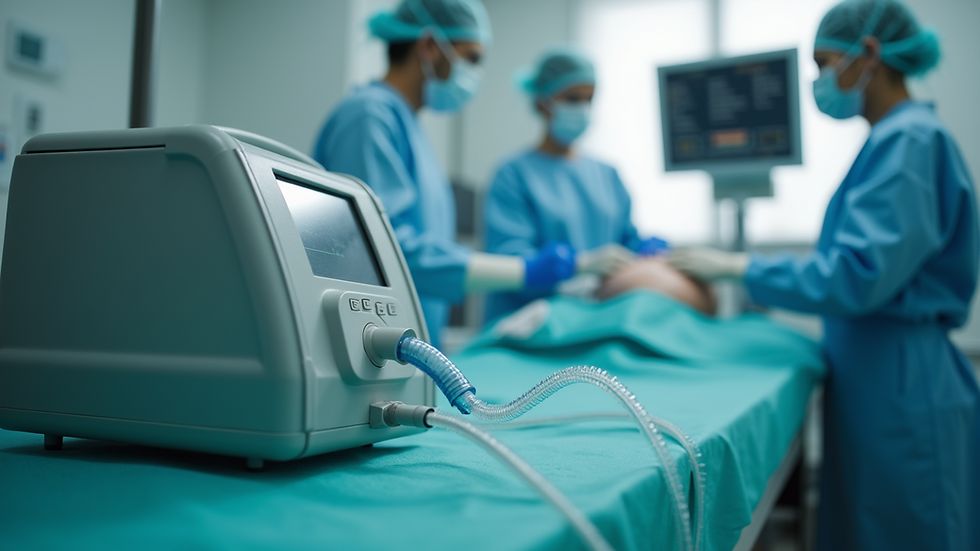Efficient Suction Machines for Medical Settings
- kurejo
- May 11
- 5 min read
In the fast-paced world of healthcare, efficiency is key. Medical professionals rely on various tools to provide the best care possible. One such tool is the suction machine. These machines play a crucial role in many medical settings, from hospitals to outpatient clinics. Understanding their importance and how to choose the right one can make a significant difference in patient care.
Suction machines are designed to remove fluids, secretions, and debris from a patient's airway or surgical site. They help maintain clear airways, prevent infections, and ensure that medical procedures can be performed safely. In this blog post, we will explore the different types of suction machines, their features, and how to select the best one for your needs.
Types of Suction Machines
Suction machines come in various types, each designed for specific applications. Here are the most common types:
1. Portable Suction Machines
Portable suction machines are lightweight and easy to transport. They are ideal for emergency situations or home care settings. These machines often run on batteries, making them convenient for use in areas without immediate access to power.
2. Wall-Mounted Suction Machines
Wall-mounted suction machines are typically found in hospitals and clinics. They are connected to the facility's vacuum system and provide a continuous suction source. These machines are powerful and can handle larger volumes of fluid, making them suitable for surgical procedures.
3. Electric Suction Machines
Electric suction machines are versatile and can be used in various settings. They are powered by electricity and often come with adjustable suction settings. This feature allows healthcare providers to customize the suction strength based on the patient's needs.
4. Manual Suction Devices
Manual suction devices are simple and do not require electricity. They are often used in emergency situations or in areas where power is unavailable. While they may not be as powerful as electric machines, they can still effectively clear airways.
Key Features to Consider
When selecting a suction machine, it is essential to consider several key features. These features can impact the machine's performance and usability.
1. Suction Power
The suction power of a machine is measured in mmHg. Higher suction power is often necessary for surgical procedures, while lower power may be sufficient for routine airway clearance. Always check the specifications to ensure the machine meets your needs.
2. Collection Canister Size
The size of the collection canister determines how much fluid the machine can hold before needing to be emptied. Larger canisters are beneficial in high-volume situations, while smaller canisters may be more suitable for home care.
3. Portability
If you need a suction machine for emergency situations or home care, portability is crucial. Look for lightweight models with a compact design that can be easily transported.
4. Noise Level
Some suction machines can be quite noisy, which may be disruptive in a clinical setting. Consider the noise level when selecting a machine, especially if it will be used in a patient room.
5. Ease of Cleaning
Suction machines require regular cleaning to prevent infections. Choose a model that is easy to disassemble and clean. This feature will save time and ensure the machine remains hygienic.
Choosing the Right Suction Machine
Selecting the right suction machine involves understanding your specific needs. Here are some steps to help you make an informed decision:
1. Assess Your Environment
Consider where the suction machine will be used. If it is for a hospital or clinic, a wall-mounted or electric model may be best. For home care or emergency situations, a portable model is likely more suitable.
2. Determine the Intended Use
Think about the primary purpose of the suction machine. Will it be used for routine airway clearance, surgical procedures, or emergency situations? This will help you narrow down your options.
3. Consult with Colleagues
If you are unsure which model to choose, consult with colleagues or other healthcare professionals. They may have valuable insights based on their experiences with different machines.
4. Read Reviews
Before making a purchase, read reviews from other users. This can provide you with a better understanding of the machine's performance and reliability.
5. Consider Budget
Suction machines can vary significantly in price. Determine your budget and look for models that offer the best value for your needs.
Maintenance and Care
Proper maintenance is essential for ensuring the longevity and effectiveness of suction machines. Here are some tips for keeping your machine in top condition:
1. Regular Cleaning
Clean the collection canister and tubing after each use. This will help prevent the buildup of bacteria and ensure the machine operates effectively.
2. Check for Blockages
Regularly inspect the tubing and filters for blockages. Clear any obstructions to maintain optimal suction power.
3. Perform Routine Checks
Conduct routine checks on the machine's components, including the motor and suction gauge. This will help identify any issues before they become significant problems.
4. Follow Manufacturer Guidelines
Always follow the manufacturer's guidelines for maintenance and care. This will ensure that you are using the machine correctly and prolong its lifespan.
Real-World Applications
Suction machines are used in various medical settings, each with unique applications. Here are a few examples:
1. Emergency Medical Services (EMS)
In emergency situations, suction machines are vital for clearing airways. Paramedics often use portable suction machines to remove fluids from a patient's mouth or throat, ensuring they can breathe.
2. Surgical Procedures
During surgeries, suction machines are used to remove blood and other fluids from the surgical site. This helps maintain a clear view for the surgeon and reduces the risk of infection.
3. Home Care
For patients with chronic respiratory conditions, suction machines can be used at home to clear secretions. This helps improve their quality of life and reduces hospital visits.
4. Pediatric Care
In pediatric settings, suction machines are essential for clearing airways in infants and young children. Their small size and ease of use make them ideal for delicate situations.
The Future of Suction Machines
As technology advances, suction machines are becoming more efficient and user-friendly. Here are some trends to watch for in the future:
1. Smart Technology
Many manufacturers are incorporating smart technology into suction machines. This includes features like automatic suction adjustment and real-time monitoring, which can enhance patient safety.
2. Improved Portability
Future models are likely to be even more portable, with longer battery life and lighter designs. This will make them more accessible for home care and emergency situations.
3. Enhanced Cleaning Features
New designs may include self-cleaning features, reducing the time and effort required for maintenance. This will help ensure machines remain hygienic and ready for use.
4. Eco-Friendly Options
As sustainability becomes a priority, manufacturers may develop eco-friendly suction machines. This could include using recyclable materials and energy-efficient designs.
Final Thoughts
Choosing the right suction machine is crucial for providing effective patient care. By understanding the different types, key features, and maintenance requirements, healthcare professionals can make informed decisions.
Investing in an efficient suction machine not only enhances patient safety but also improves the overall quality of care. As technology continues to evolve, staying informed about the latest advancements will ensure that you are equipped with the best tools for your practice.

In the ever-changing landscape of healthcare, having the right equipment can make all the difference. Suction machines are a vital part of this equation, ensuring that patients receive the care they need when they need it most.



Comentarios